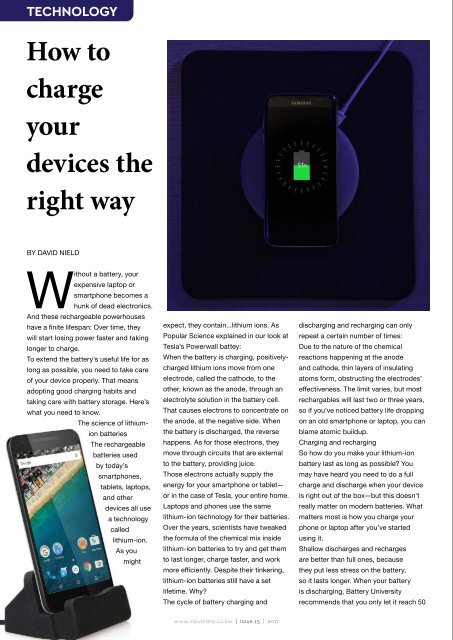inBUSINESS Issue 15
You also want an ePaper? Increase the reach of your titles
YUMPU automatically turns print PDFs into web optimized ePapers that Google loves.
TECHNOLOGY<br />
How to<br />
charge<br />
your<br />
devices the<br />
right way<br />
BY DAVID NIELD<br />
Without a battery, your<br />
expensive laptop or<br />
smartphone becomes a<br />
hunk of dead electronics.<br />
And these rechargeable powerhouses<br />
have a finite lifespan: Over time, they<br />
will start losing power faster and taking<br />
longer to charge.<br />
To extend the battery’s useful life for as<br />
long as possible, you need to take care<br />
of your device properly. That means<br />
adopting good charging habits and<br />
taking care with battery storage. Here’s<br />
what you need to know.<br />
The science of lithiumion<br />
batteries<br />
The rechargeable<br />
batteries used<br />
by today’s<br />
smartphones,<br />
tablets, laptops,<br />
and other<br />
devices all use<br />
a technology<br />
called<br />
lithium-ion.<br />
As you<br />
might<br />
expect, they contain...lithium ions. As<br />
Popular Science explained in our look at<br />
Tesla’s Powerwall battey:<br />
When the battery is charging, positivelycharged<br />
lithium ions move from one<br />
electrode, called the cathode, to the<br />
other, known as the anode, through an<br />
electrolyte solution in the battery cell.<br />
That causes electrons to concentrate on<br />
the anode, at the negative side. When<br />
the battery is discharged, the reverse<br />
happens. As for those electrons, they<br />
move through circuits that are external<br />
to the battery, providing juice.<br />
Those electrons actually supply the<br />
energy for your smartphone or tablet—<br />
or in the case of Tesla, your entire home.<br />
Laptops and phones use the same<br />
lithium-ion technology for their batteries.<br />
Over the years, scientists have tweaked<br />
the formula of the chemical mix inside<br />
lithium-ion batteries to try and get them<br />
to last longer, charge faster, and work<br />
more efficiently. Despite their tinkering,<br />
lithium-ion batteries still have a set<br />
lifetime. Why?<br />
The cycle of battery charging and<br />
discharging and recharging can only<br />
repeat a certain number of times:<br />
Due to the nature of the chemical<br />
reactions happening at the anode<br />
and cathode, thin layers of insulating<br />
atoms form, obstructing the electrodes’<br />
effectiveness. The limit varies, but most<br />
rechargables will last two or three years,<br />
so if you’ve noticed battery life dropping<br />
on an old smartphone or laptop, you can<br />
blame atomic buildup.<br />
Charging and recharging<br />
So how do you make your lithium-ion<br />
battery last as long as possible? You<br />
may have heard you need to do a full<br />
charge and discharge when your device<br />
is right out of the box—but this doesn’t<br />
really matter on modern batteries. What<br />
matters most is how you charge your<br />
phone or laptop after you’ve started<br />
using it.<br />
Shallow discharges and recharges<br />
are better than full ones, because<br />
they put less stress on the battery,<br />
so it lasts longer. When your battery<br />
is discharging, Battery University<br />
recommends that you only let it reach 50<br />
36<br />
www.inbusiness.co.bw | <strong>Issue</strong> <strong>15</strong> | 2017
















